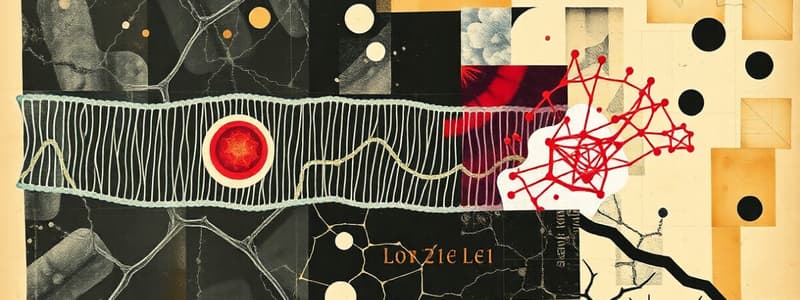Podcast
Questions and Answers
What is the primary function of the electron transport chain?
What is the primary function of the electron transport chain?
- Convert light energy into chemical energy
- Facilitate the Calvin cycle in chloroplasts
- Split water molecules to release oxygen
- Transfer electrons from NADH and FADH2 to produce ATP (correct)
In which part of the plant cell does the Calvin Cycle occur?
In which part of the plant cell does the Calvin Cycle occur?
- Cytoplasm
- Stroma of chloroplasts (correct)
- Inner mitochondrial membrane
- Thylakoid membranes
Which of the following statements about aerobic and anaerobic respiration is correct?
Which of the following statements about aerobic and anaerobic respiration is correct?
- Aerobic respiration does not require oxygen, while anaerobic does.
- Anaerobic respiration produces more ATP than aerobic respiration.
- Aerobic respiration requires oxygen for energy production. (correct)
- Both types of respiration occur in the mitochondria.
What is produced as a byproduct during the light-dependent reactions of photosynthesis?
What is produced as a byproduct during the light-dependent reactions of photosynthesis?
What is the overall equation for photosynthesis?
What is the overall equation for photosynthesis?
What is the primary function of proteins embedded in the cell membrane?
What is the primary function of proteins embedded in the cell membrane?
Which type of signaling involves a cell signaling itself?
Which type of signaling involves a cell signaling itself?
During which phase of the cell cycle does DNA replication occur?
During which phase of the cell cycle does DNA replication occur?
What role do cyclins and cyclin-dependent kinases (CDKs) play in the cell cycle?
What role do cyclins and cyclin-dependent kinases (CDKs) play in the cell cycle?
What is the first step of cellular respiration?
What is the first step of cellular respiration?
Which of the following components is specifically classified as a second messenger in cell signaling?
Which of the following components is specifically classified as a second messenger in cell signaling?
Which process results in two identical daughter cells?
Which process results in two identical daughter cells?
In cellular respiration, which phase takes place in the mitochondria?
In cellular respiration, which phase takes place in the mitochondria?
Flashcards are hidden until you start studying
Study Notes
Electron Transport Chain
- Situated in the inner mitochondrial membrane; crucial for aerobic respiration.
- Transfers electrons from NADH and FADH2 through a series of proteins.
- Establishes a proton gradient that drives ATP synthesis.
Oxygen Requirement
- Aerobic respiration requires oxygen for ATP production.
- Anaerobic respiration occurs in the absence of oxygen, utilizing fermentation processes.
Photosynthesis
- Converts light energy into chemical energy (glucose) using carbon dioxide and water.
- Primarily takes place in chloroplasts of plant cells.
Photosynthesis Phases
-
Light-dependent Reactions:
- Occur in thylakoid membranes.
- Transform solar energy into ATP and NADPH; split water and release oxygen.
-
Calvin Cycle (Light-independent Reactions):
- Takes place in the stroma of chloroplasts.
- Utilizes ATP and NADPH to convert CO2 into glucose.
- Overall equation: 6 CO2 + 6 H2O + light energy → C6H12O6 + 6 O2.
Cell Membrane Structure
- Composed of a phospholipid bilayer, proteins, cholesterol, and carbohydrates.
- Phospholipids have hydrophilic heads and hydrophobic tails, creating a semi-permeable membrane.
- Integral and peripheral proteins aid in transport, signaling, and structural integrity.
- The Fluid Mosaic Model illustrates the dynamic nature of the cell membrane.
Cell Signaling Pathways
- Involves a series of molecular interactions leading to cellular responses.
Types of Signals
- Autocrine: Cells signal themselves.
- Paracrine: Signals travel to adjacent cells.
- Endocrine: Hormones circulate in the bloodstream.
Receptors
- Membrane-bound: Bind to external signals, triggering internal pathways.
- Intracellular: Bind to signals that can penetrate the cell membrane.
Pathway Components
- Ligands: Molecules that convey signals.
- Signal Transduction: Converts a signal into a functional response.
- Second Messengers: Molecules like cAMP that amplify the signal within cells.
Cell Cycle and Division
- Consists of several phases controlling cell growth and division.
Phases of the Cell Cycle
-
Interphase:
- G1 Phase: Growth and protein synthesis.
- S Phase: DNA replication occurs.
- G2 Phase: Prepares the cell for mitosis with growth and organelle duplication.
-
Mitosis: Division resulting in two genetically identical daughter cells.
- Phases include Prophase, Metaphase, Anaphase, and Telophase.
-
Cytokinesis: Physical separation of the cytoplasm into daughter cells.
Regulation of the Cell Cycle
- Cyclins and cyclin-dependent kinases (CDKs) regulate progression through the cycle.
- Critical checkpoints (G1, G2, and M) ensure accurate cell cycle progression and genetic integrity.
Cellular Respiration
- Converts glucose and oxygen into ATP, carbon dioxide, and water.
Phases of Cellular Respiration
- Glycolysis: Takes place in the cytoplasm; breaks glucose into pyruvate while generating ATP and NADH.
- Krebs Cycle (Citric Acid Cycle): Occurs in mitochondria; processes pyruvate into CO2, generating ATP, NADH, and FADH2.
Studying That Suits You
Use AI to generate personalized quizzes and flashcards to suit your learning preferences.




